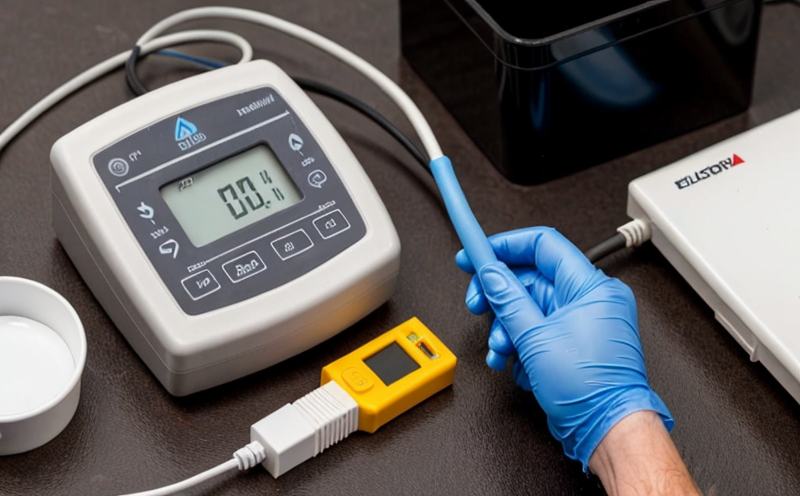NF EN 12495 Electrochemical Testing of Marine Installations
The NF EN 12495 standard specifies the method for electrochemical testing to assess the corrosion resistance and integrity of marine installations. This test is crucial in ensuring that structures, materials, and components used in maritime environments meet stringent safety and performance criteria.
The electrochemical testing process involves subjecting specimens under controlled conditions to evaluate their susceptibility to corrosion. The standard aims to provide a standardized method for assessing the effectiveness of protective coatings on marine installations against saltwater exposure. This approach helps prevent premature failure due to corrosion, which can be detrimental to maritime operations and safety.
The NF EN 12495 testing protocol is designed for use with various materials commonly found in marine environments such as steel, aluminum, zinc, and stainless steel. The test parameters include immersion time, electrode spacing, current density, and polarization potential. Specimen preparation involves cleaning the surface to remove contaminants that could interfere with the electrochemical reaction.
In this testing process, a three-electrode system is used where the specimen acts as the working electrode, while reference and counter electrodes are positioned around it. The test setup ensures accurate measurement of corrosion parameters such as hydrogen evolution rate (HER) and open circuit potential (OCP). By monitoring these values over time, engineers can determine the effectiveness of protective layers in preventing corrosion.
The acceptance criteria for NF EN 12495 are based on predefined limits for corrosion rates. The standard specifies permissible levels of weight loss or hydrogen evolution that indicate acceptable performance of protective coatings against corrosive environments. Compliance with these criteria ensures that marine installations meet the required safety standards and can operate efficiently in challenging conditions.
For quality managers, compliance officers, and R&D engineers involved in maritime projects, understanding NF EN 12495 is essential for ensuring the reliability and longevity of materials used in shipbuilding and offshore structures. By adhering to this standard, organizations demonstrate their commitment to maintaining high-quality products that comply with international regulations.
Scope and Methodology
| Parameter | Description |
|---|---|
| Electrode Type | Silver/AgCl reference electrode, Calomel reference electrode |
| Polarization Potential | +250 mV to -850 mV (vs. Ag/AgCl) |
| Immersion Time | 168 hours ± 4 hours at 37°C |
| Solution Concentration | 3.5% NaCl solution with 0.2 g/l sodium carbonate |
The scope of NF EN 12495 encompasses the electrochemical testing procedures for determining the corrosion resistance of materials used in marine installations. The methodology involves immersing specimens in a controlled saltwater environment to simulate real-world conditions experienced by maritime structures.
The test begins with cleaning and preparing the specimen surfaces, followed by setting up the three-electrode system according to specified parameters. During testing, the polarization potential is applied for a predefined duration at various levels, allowing the monitoring of corrosion behavior under different stress conditions.
At the end of the immersion period, the specimens are removed from the solution and thoroughly dried before weighing to measure any changes in mass due to corrosion. The hydrogen evolution rate (HER) is also measured using a gas collection apparatus. These results form the basis for evaluating compliance with acceptance criteria outlined in the standard.
Industry Applications
- Shipbuilding: Ensuring longevity and safety of hull structures
- Offshore Oil & Gas: Protecting platforms from corrosion damage
- Marine Pipelines: Maintaining integrity in harsh saltwater environments
- Marine Platforms: Enhancing durability and performance in maritime operations
The NF EN 12495 electrochemical testing method is widely used across various sectors, particularly those involving exposure to marine environments. This includes shipbuilding companies, offshore oil & gas operators, marine pipeline constructors, and platform owners who rely on accurate corrosion assessments for their critical assets.
By leveraging this standardized approach, these industries can ensure that all materials employed in marine installations undergo rigorous evaluation before deployment. The insights gained from NF EN 12495 testing help stakeholders make informed decisions about material selection and protective measures to enhance the performance and safety of maritime structures.
Customer Impact and Satisfaction
- Achieving compliance with international standards for quality assurance
- Increase in customer trust through transparent testing processes
- Promoting long-term reliability of marine installations
- Reduction in maintenance costs due to extended component life
The implementation of NF EN 12495 electrochemical testing has significant positive impacts on customers within the maritime industry. Compliance with this standard demonstrates a commitment to quality and safety, thereby enhancing customer trust. Reliable materials tested according to this protocol lead to longer-lasting installations, reducing the need for frequent maintenance and repairs.
Engineers responsible for designing and constructing marine structures benefit from more accurate data provided by NF EN 12495 testing. This allows them to select appropriate protective coatings that meet stringent performance requirements. As a result, customers experience enhanced satisfaction knowing their investments are protected against corrosion-related issues.





